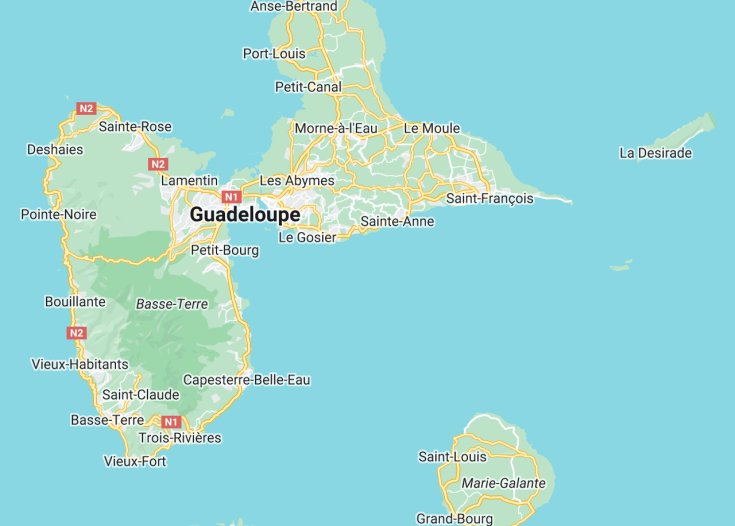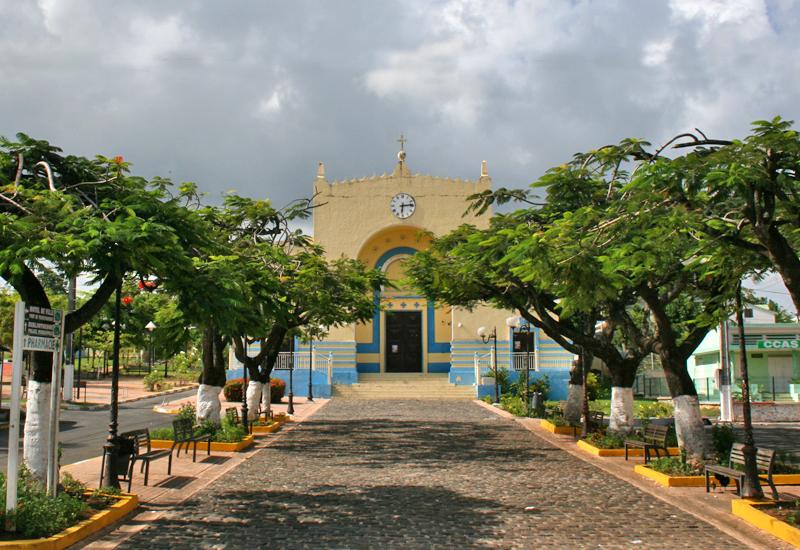Guadeloupe, an archipelago located in the heart of the Caribbean, weaves French elegance with Creole vibrancy. Known for its sun-kissed beaches, verdant rainforests, and the majestic La Grande Soufrière volcano, this French overseas territory is a medley of culture, nature, and history, offering a unique tropical escape.
French is predominantly spoken; picking up basic phrases or carrying a translation app can enhance your experience.
Explore beyond the main islands; smaller islets like Les Saintes harbor unique charm and fewer tourists.
Top destinations in Guadeloupe (France)
Guadeloupe: The Butterfly Island of the Caribbean
| Capital | Basse-Terre |
| Time in Guadeloupe | GMT-4 |
| Language spoken | French |
| Population | Approximately 400,000 (Source: World Bank) |
| Religion | Christianity (88%) Other religions (7%) Unaffiliated or non-religious (5%) |
| Currency | Euro (€, EUR) |
| Airports | Pointe-à-Pitre International Airport Baillif Airport La Désirade Airport |
Guadeloupe, a mesmerizing tapestry of culture, nature, and history, beckons travelers with its myriad hues and tales. As a part of the French Antilles, this archipelago in the Caribbean stands as a perfect blend of European elegance and Caribbean vibrancy. Its historical significance is deeply rooted, with the remnants of colonial influence juxtaposed against indigenous heritage.
The islands of Guadeloupe unfold a treasure trove for the discerning traveler. From the bustling markets of Pointe-à-Pitre to the serene shores of Grande-Terre and the verdant landscapes of Basse-Terre, every corner tells a story. Historically, Guadeloupe has been a coveted prize for colonial powers, leading to a rich tapestry of cultural exchanges. The influences of the indigenous Caribs, African descendants, and European settlers have coalesced to shape its unique identity.
For tourists, Guadeloupe promises more than just scenic vistas. It is an immersive experience. The aroma of Creole cuisine wafts through the air, the rhythms of zouk music enchant the soul, and the warm smiles of the locals make every visitor feel at home. Moreover, the island’s commitment to eco-tourism, with its protected marine reserves and national parks, resonates deeply with those seeking sustainable travel experiences. In essence, Guadeloupe is where memories are etched, and stories are born, making it a must-visit destination for all.
Where is Guadeloupe located?
Guadeloupe is an enchanting archipelago nestled in the Caribbean Sea, southeast of Puerto Rico. It is a key constituent of the French Antilles, offering a slice of Europe amidst tropical splendor.
What is Guadeloupe famous for?
Guadeloupe is renowned for its rich cultural tapestry, captivating Creole cuisine, and rhythmic zouk music. Additionally, its diverse landscapes, ranging from sun-kissed beaches to lush rainforests, make it a haven for nature enthusiasts and adventurers alike.
History
Pre-Columbian Era: Native Inhabitants
Long before the Europeans arrived, Guadeloupe was inhabited by the indigenous Arawak people who settled there around 300 AD. They were later displaced by the Caribs, a more aggressive group who named the island “Karukera,” meaning “Island of Beautiful Waters.”
1493-1674: Discovery and Early Colonial Struggles
In 1493, during his second voyage to the New World, Christopher Columbus became the first European to set foot on Guadeloupe, naming it after the Spanish monastery of Santa María de Guadalupe. However, it wasn’t until the early 17th century that European powers, particularly the French, began to establish settlements. The Caribs fiercely resisted the French and English attempts at colonization, but by 1635, the French managed to establish a foothold and began setting up sugar plantations. The English frequently raided and attempted to seize the territory, but Guadeloupe remained largely under French control.
1674-1815: Plantations, Slavery, and Political Tug-of-War
Guadeloupe’s sugar plantations thrived in the late 17th and 18th centuries, making it a valuable asset in the Caribbean. The plantations depended heavily on African slave labor. The notorious Code Noir was enacted in 1685 to regulate the treatment of slaves, which, while attempting to provide some protections, also legitimized the brutal institution. Over the years, the British and French repeatedly exchanged control of the island. The abolition of slavery in 1794 during the French Revolution was short-lived, as Napoleon reinstated it in 1802. However, the British took the island in 1810 and abolished slavery. It was returned to the French in 1815 under the Treaty of Paris, and slavery was finally abolished by the French in 1848.
1815-1946: Economic Hardships and Natural Disasters
With the abolition of slavery, the plantation system went into decline, and Guadeloupe faced significant economic hardships. The island was also hit by a series of natural disasters, including earthquakes, hurricanes, and a devastating cholera outbreak. Many inhabitants migrated to other regions in search of better opportunities. Nevertheless, the island witnessed the growth of a unique Creole culture, blending African, French, and indigenous traditions. Guadeloupe also saw political advancements, with elected representatives sent to the French National Assembly from 1871 onwards.
1946-Present: From Colony to Overseas Department
In 1946, Guadeloupe underwent a significant political transformation when it became an overseas department of France. This status granted its citizens full French rights and started a process of rapid modernization and development. Over the decades, Guadeloupe has grappled with issues of identity, economic disparity, and political representation. Tourism has become a crucial sector, showcasing the island’s rich history, vibrant culture, and stunning natural beauty. Today, while Guadeloupe remains an integral part of France, it retains a distinct identity that proudly reflects its storied past.
Visit Guadeloupe
What to see and do in Guadeloupe
Guadeloupe offers a wide range of attractions and activities for visitors to enjoy. Here are some of the top things to see and do in Guadeloupe:
- Explore the stunning beaches, such as Grande Anse, Plage de la Datcha, and Plage de la Caravelle.
- Visit the Parc National de la Guadeloupe and hike through its lush rainforests and awe-inspiring waterfalls.
- Discover the vibrant marine life by snorkeling or scuba diving in the crystal-clear waters surrounding the island.
- Experience the local culture at markets, where you can sample traditional dishes, spices, and handicrafts.
- Take a boat tour to the nearby islands of Marie-Galante, Les Saintes, and La Désirade, known for their untouched natural beauty.
- Visit historic sites such as Fort Napoléon, which offers panoramic views of the surrounding area, and the Memorial ACTe, a museum dedicated to the history of slavery.
Whether you’re looking for relaxation on the beach, outdoor adventures, or cultural immersion, Guadeloupe has something for everyone.
Events in Guadeloupe
Guadeloupe hosts several events throughout the year that showcase its vibrant culture and traditions. Here are some of the major events to experience in Guadeloupe:
- Carnival (February/March): This colorful festival is a major celebration in Guadeloupe, featuring parades, music, costumes, and dancing.
- Fête des Cuisinières (August): This culinary festival honors the island’s traditional cuisine and showcases the skills of local cooks.
- Festival Terre de Blues (May/June): This international music festival brings together renowned artists from the Caribbean and around the world.
- Fête de la Canne (June): This festival celebrates the island’s sugar cane heritage with live music, food stalls, and cultural performances.
- Fête de Saint-Jean (June): This religious festival is held in various towns across Guadeloupe and features processions, fireworks, and traditional dances.
These events offer a glimpse into Guadeloupe’s vibrant culture and are a great way to immerse yourself in the local traditions.
Best time to visit Guadeloupe
The best time to visit Guadeloupe is during the dry season, which runs from December to May. This period offers pleasant weather with temperatures averaging between 75°F (24°C) and 85°F (29°C), making it ideal for outdoor activities and beach visits. It’s important to note that Guadeloupe experiences a tropical climate, and there is a chance of rain throughout the year. The wet season, from June to November, brings higher temperatures and increased humidity, but it also offers lower prices and fewer tourists. Overall, the best time to visit depends on your preferences and priorities. If you want to avoid the crowds and enjoy lower prices, the wet season may be a good option. However, if you’re looking for the best weather for outdoor activities and beach relaxation, the dry season is the recommended time to visit.
Is Guadeloupe worth visiting?
Guadeloupe is definitely worth visiting for those looking to experience a unique blend of French and Caribbean culture. Its stunning beaches, lush rainforests, and vibrant festivals make it an attractive destination for nature lovers, adventure seekers, and cultural enthusiasts. However, it’s important to note that while Guadeloupe offers a diverse range of attractions, it may not be the ideal destination for everyone. The island’s infrastructure and tourism services may not be as developed as some other popular Caribbean destinations. Additionally, English is not as widely spoken as French, so it’s helpful to have some knowledge of French or be willing to communicate through gestures and basic phrases. Overall, if you’re looking for a destination off the beaten path, where you can immerse yourself in a rich cultural experience and enjoy beautiful natural surroundings, Guadeloupe is worth considering. It offers a unique blend of Caribbean charm and French sophistication that sets it apart from other tropical destinations.













